An Autumn Migration group day tour in North Norfolk today. The clocks had changed overnight so it felt like a later start than it was when we met up in the morning. The forecast was for showers, particularly around the middle of the day, but it ended up drizzling on and off for much of the morning. Unperturbed, we carried on and we were very glad we did! Thankfully, then it cleared and brightened up into the afternoon.
As we set off on our way up towards the coast, a Chiffchaff flicked across the road ahead of us and into the hedge the other side – a reminder of how mild it has been so far. Our destination for the morning was Cley and thankfully we managed to find somewhere to park at Walsey Hills. With a couple of rarities around the area yesterday, there were quite a few cars here already, presumably mostly come to admire the Long-billed Dowitcher at nearby Salthouse.
First, we stopped to scan Snipe’s Marsh and it didn’t take long to find a Jack Snipe out on the mud. It was well hidden at first, crouched in amongst the stubs of the cut reed, and all we could see were the horizontal golden stripes on its back. But then helpfully it started to feed – it’s distinctive bouncing now making it much easier to see.

We wanted to head round to the Iron Road to look for the Long-billed Dowitcher ourselves, but it was very grey and overcast so we figured it might be better going there later and starting out along the East Bank. A distant Marsh Harrier was out over the reedbed and a Little Grebe was diving on Don’s Pool. A male Gadwall on the edge of the reeds was still emerging from eclipse.
We hadn’t gone much further along the bank before it started to drizzle. We continued on up to the Serpentine, and stopped to scan. A Lapwing was on the grass by one of the small pools and there were a few Black-tailed Godwits and an Avocet on the Serpentine itself. We noticed a group of smaller waders on the wet grass just beyond to we walked a little further and got them in the scope. There were two Little Stints with the Dunlin and we had some nice views of them feeding together despite the rain.
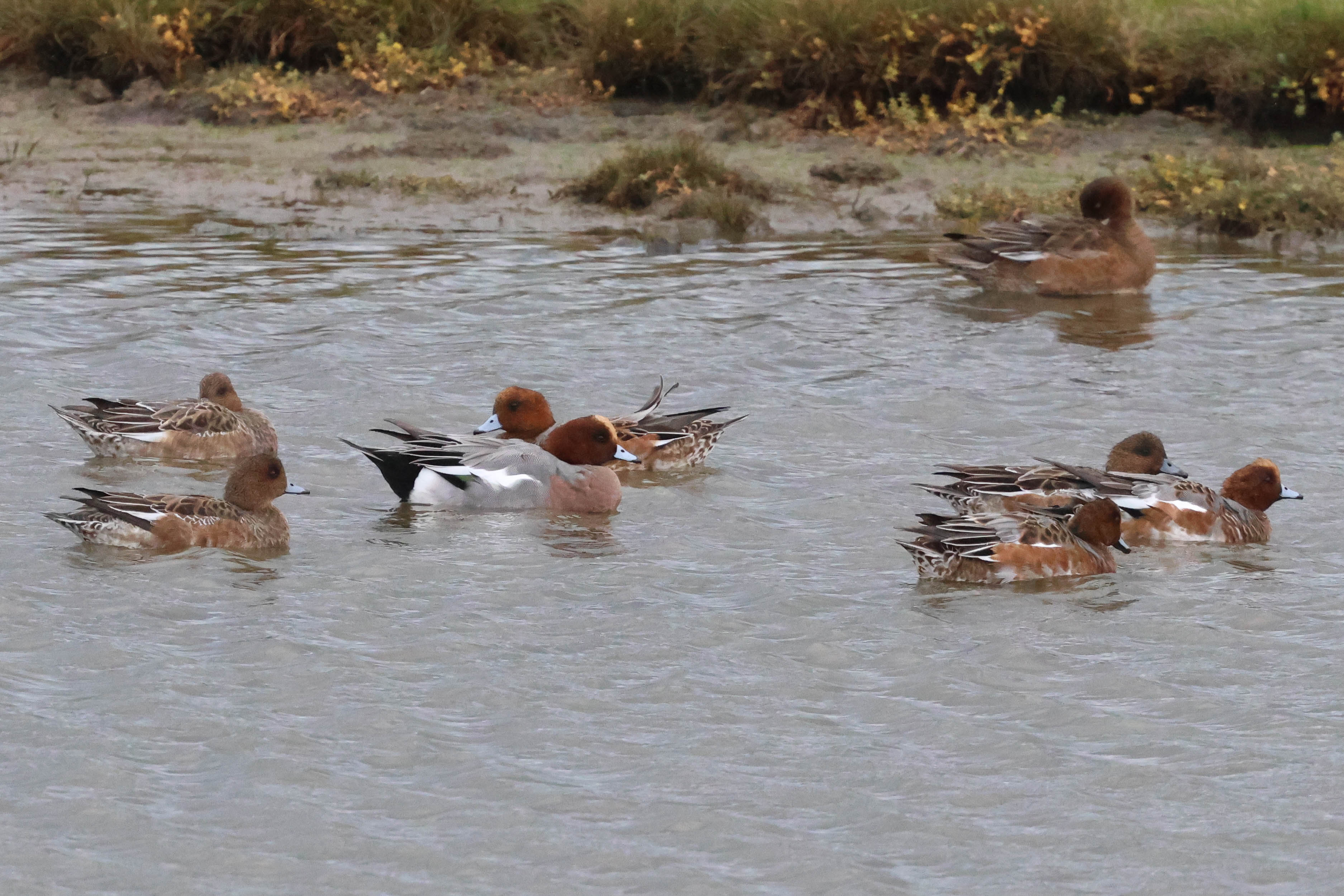
Looking further out, towards Pope’s Pool, there were more Black-tailed Godwits and a couple more Avocets. A Turnstone and two Ringed Plovers were feeding on the grass just in front. A lone Common Snipe was standing out in the open on top of one of the islands, its long bill out facing into the rain, given us a chance to compare with the Jack Snipe we had just seen earlier. There were lots of Wigeon on the pool too, along with a Shelduck and a couple of Shoveler.
We heard occasional pinging from the reedbed behind us but looking across we couldn’t actually see any Bearded Tits today. There were several Reed Buntings flying in and out of the reeds. A Water Rail squealed from somewhere in the reeds and a couple of Cetti’s Warblers remained typically elusive while shouting from deep in cover. A young Marsh Harrier perched in one of the tamarisk bushes out in the middle. A skein of Pink-footed Geese headed off inland over North Foreland wood calling.
With the drizzle intensifying, we made for the shelter overlooking Arnold’s Marsh. There were lots more Dunlin feeding on here this morning, presumably pushed out of the harbour by the tide, but despite scanning through carefully we couldn’t find anything different in with them. More Turnstones and Ringed Plovers were scattered around the shingle islands. There were Redshank and one or two Curlew too, and several Grey Plover including one in the samphire closer to the hide.
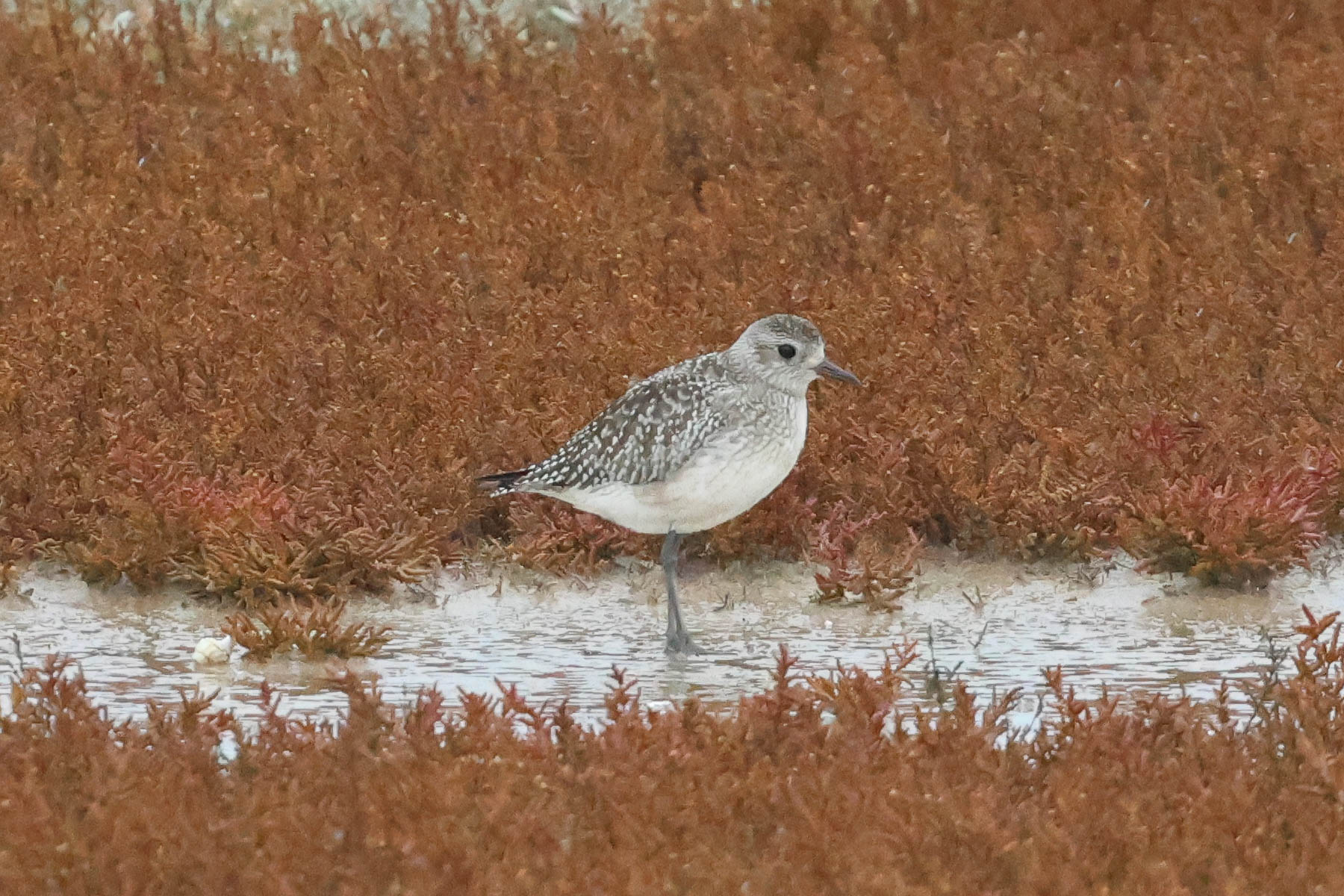
A small group of Ruff were feeding in the samphire off to our left too, mostly juveniles with one female dwarfed by the much larger males. There were two orange-legged adults, one white-headed and the other more conventionally grey. Ruff really are the most confusing of waders for the uninitiated!
The sky seemed to be brightening a little away to the west, so we went out on the other side of the shelter to scan the brackish pools. A Kingfisher shot across in a flash of electric blue and disappeared down into the main drain. We couldn’t see any Pintail from here today, but there were lots more Shoveler and Teal dozing round the edges. A large flock of Golden Plover came up from the scrapes in the middle of the reedbed in the distance and whirled round high in the sky.
It was while scanning from here that the plan for the morning suddenly changed. A small bird caught our eye as it flew up onto the rope fence way out on the beach behind the brackish pools, over towards the old North Hide. It was only there for a second before it dropped down again but the first reaction was that it looked different, rather ‘chatty’. So when a Kestrel flew over the shingle and it flicked up onto the rope again we quickly got it in the scope. It was indeed a chat, but not one we were expecting today – it was a male Desert Wheatear!
Everyone had a look at the Desert Wheatear through the scope, noting its black face and black wings, contrasting with its sandy body. When it dropped down again, we made our way quickly out of the beach and along towards North Hide over the shingle to try to get a closer look. But despite scanning we couldn’t find it again at first.
There were a few other distractions – a lone Golden Plover on the shingle, flocks of Linnets and Goldfinches, a Red-throated Diver close in off the beach. We could see a moulting drake Pintail now from here on the brackish pool. There was a report of a Pallid Harrier flying in our direction from Salthouse, but despite scanning we couldn’t find it, and it sounded like it had dropped down in the reeds.
We put the news out about the Desert Wheatear and quickly reinforcements arrived from the direction of the beach car park. Looking out from the old hide someone relocated it now on the back of the shingle further along. Finally we could get a better look at it. It was very active, perching up on the dead yellow-horned poppy seedheads, then dropping down onto the stones, running around chasing insects, flying back and forth. When it flew, we could see its distinctive square pale rump and black tail.
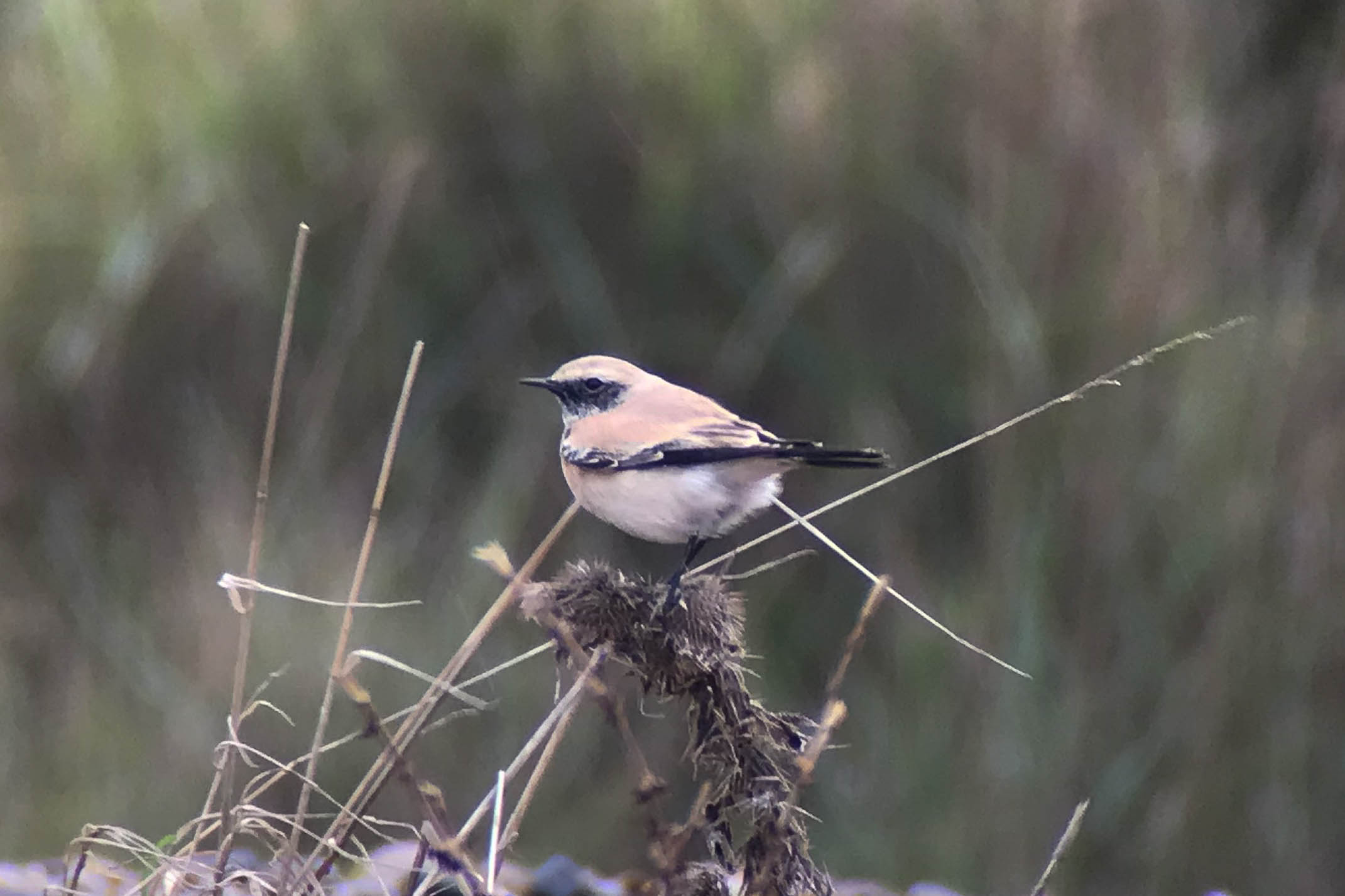
Desert Wheatear is a rare vagrant to the UK, averaging only about 4-5 records a year nationally. It breeds in North Africa, the Middle East and through Central Asia, with birds from the eastern part of the range migrating to North Africa to winter. A fantastic bird for us to find on our day out today!
There was quite a crowd starting to gather, so having had great looks at the Desert Wheatear, we decided to move on. We had a quick look to see if there were any Snow Buntings along the beach north of Arnold’s Marsh, but we were a bit late now and there had been quite a few people walking through the area. Rather than continue round to Salthouse how, we decided to make our way slowly back.
From the East Bank, we could see a couple of adult Gannets circling just offshore now, catching the light as they turned. We stopped again at the Serpentine – now that the rain had stopped, we could have a more leisurely look at some of the birds we had seen more briefly on the way out. The Little Stints were still showing well with the Dunlin. Back at Snipe’s marsh, the Jack Snipe was now standing out on a more open patch of mud, so we stopped for another look at that.

It had certainly been an exciting morning, so now we headed round to the Visitor Centre for a break and some lunch. With the weather much improved, we sat at the picnic tables and looked out across the reserve. Even here, there were good birds to see. A shout from up on the balcony alerted us that the Pallid Harrier had reappeared. We couldn’t see it at first – we subsequently found it had dropped onto Simmond’s Scrape and was obscured by reeds from where we were. All we could see was a Marsh Harrier circling.
Then the Pallid Harrier came up again. We watched as it flew low across over the scrapes, before gaining height and heading over the hides. It was distinctively smaller and slimmer than the Marsh Harriers, a juvenile, orangey below and dark above with a white square at the base of its tail. As it flew out over the Eye Field, it was chased by two corvids and we eventually lost sight of it as it disappeared over the West Bank and dropped towards Blakeney Freshes. Another good rarity here!
After lunch, we drove back towards Salthouse. There was nowhere to park now at Walsey Hills or at Iron Road itself, so we stopped in the village and walked back carefully along the road. As we walked down Iron Road, a couple of flocks of Starlings flew over heading west. They are just arriving now, coming in over the sea from Scandinavia for the winter.
The Long-billed Dowitcher was feeding obligingly down at the front of the pool when we arrived at the gate, so we got the scope straight on it. Like a rather plain grey snipe, it was feeding very actively, probing its long bill repeatedly into the water like a sewing machine. Long-billed Dowitcher is another rare visitor here, breeding mainly in Alaska and NE Siberia and wintering in the southern USA and Central America. Juveniles like this one occasionally turn up in the UK, mainly in the autumn. Another nice bird to see. When it flew over to the back of the pool, we walked a bit further up.
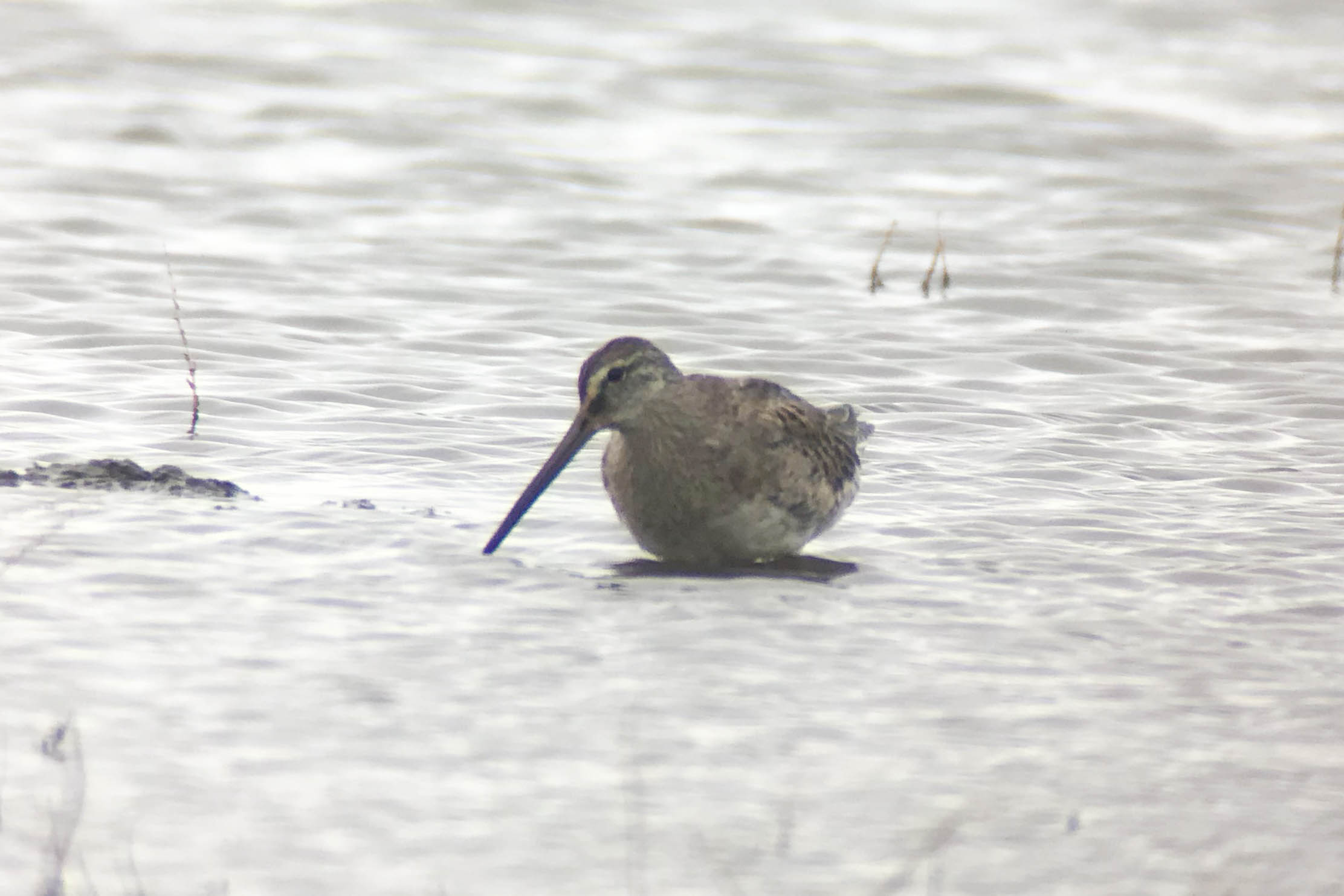
A large flock of Linnets whirled up occasionally from the weedy dried up pool in the field opposite. Some people looking out that way told us roughly where the Shorelarks were but they were still very tricky to see, creeping around in the weeds. Occasionally a head would come up with a yellow face and black mask. We could see three, but there have been up to seven here in recent days. There were several Skylarks in here too.
Turning our attention back to the main pool, we scanned along the back edge. As well as a couple of Common Snipe, we found a single Jack Snipe too, our second of the day.
We had done very well at Cley and Salthouse today. With the clock change, we would not have too much more time now this afternoon before the light started to go, so with that in mind we headed round to Blakeney Freshes to try our luck at finding some owls. As we walked out along the bank we stopped to admire the view of Cley Mill. There were obviously a few thrushes arriving from the continent this afternoon, as first a Fieldfare flew in past us and then a Song Thrush flew up out of the saltmarsh further out.
The Marsh Harriers were starting to gather to roost. A couple circled distantly over the reedbed at Cley and while we were scanning three more flew in over the Freshes and continued overhead towards Cley. A couple of Common Buzzards were perched on the posts out on the Freshes too. A flock of Brent Geese flew over chattering and disappeared off towards Blakeney Harbour and a lone Pink-footed Goose flew over high calling, presumably looking for more geese to roost with.
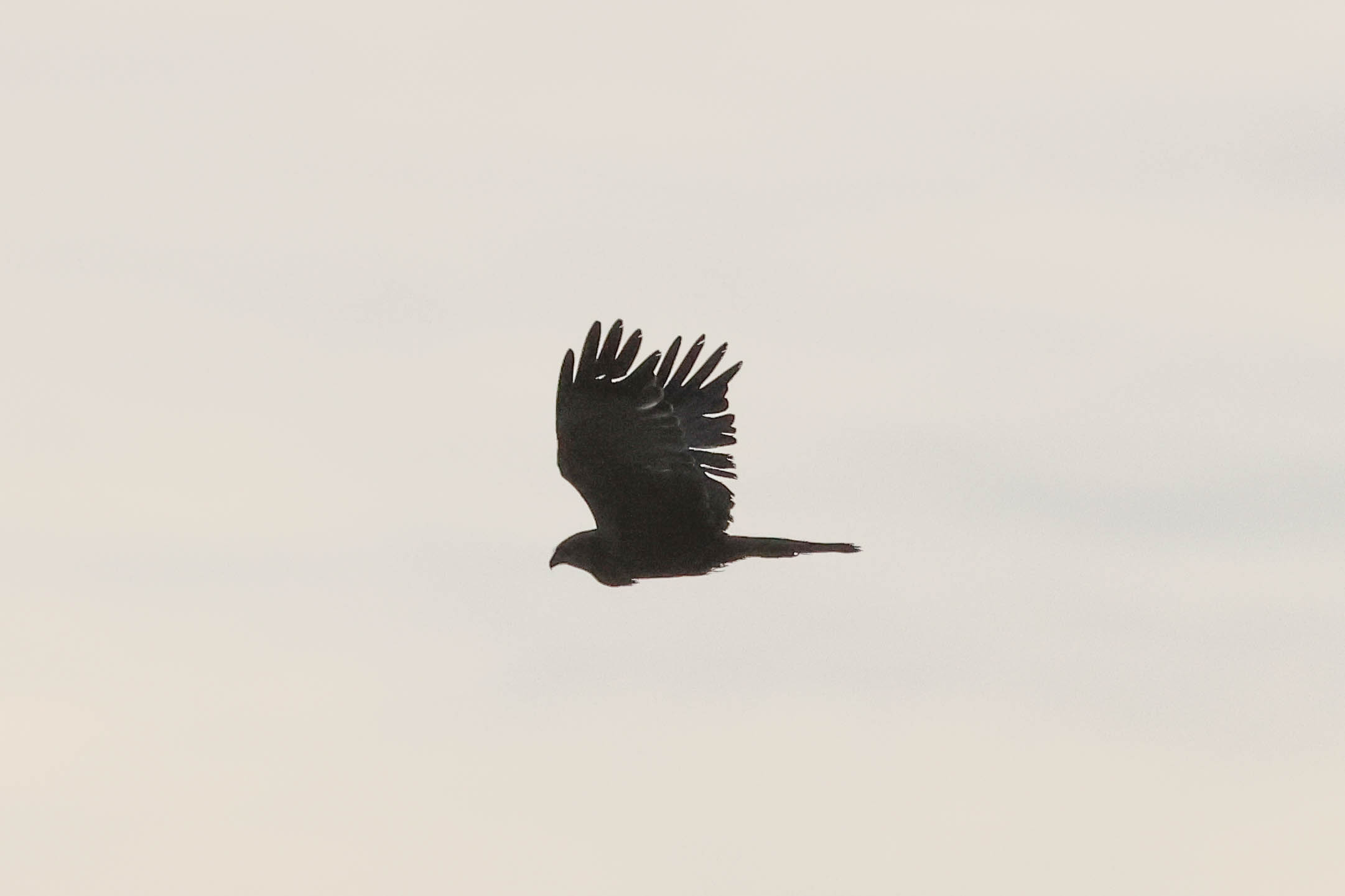
We continued out to the Blakeney Chapel corner and stopped to scan. There had been a Short-eared Owl around in recent nights, but the time it had been first seen recently came and went. There was no sign of any Barn Owls tonight either – a couple of Little Egrets and a Black-headed Gull were the only pale birds flying out over the saltmarsh now. Eventually, with the light starting to go, it was time to start walking back.
We hadn’t gone too far when we noticed a couple of people on Cley West Bank focusing their scopes on something behind us. We turned and there was the Short-eared Owl, quartering now where we had been standing a couple of minutes earlier. We watched as it flew up and down a couple of times, with its distinctive stiff-winged rowing wing action. We walked back to the Chapel corner, but by the time we got back it was heading off west.
One of the group looked round behind us, and there was a Barn Owl out now too, hunting one of the fields back along the bank. We walked back and watched it flying round, up and down along the back edge of the field in the last of the light.
Better late then never – two owls, a nice way to wrap up the day. What a day!
















